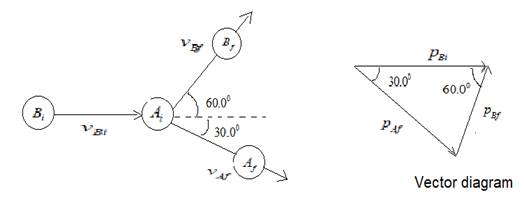
The velocity of each ball after collision.
Answer to Problem 29PP
Final velocity of the stationary ball is
Final velocity of the moving ball is
Explanation of Solution
Given:
Let
Both the balls are identical and their mass is
Since the ball
Initial velocity of the ball
After the collision the ball
This can be diagrammatically represented as shown in the figure

Figure 1.
Formula used:
Since the momentum is conserved, initial momentum of the system is equal to the final momentum of the system. That is,
In this problem,
Therefore,
From the vector diagram, the equation for final momentum of the ball
And, the equation for final momentum of the ball
But the momentum
Applying this relation, equations
And,
Where,
Calculation:
Final velocity of the ball
Final velocity of the ball
Conclusion:
Final velocity of the stationary ball is
Final velocity of the moving ball is
Chapter 9 Solutions
Glencoe Physics: Principles and Problems, Student Edition
Additional Science Textbook Solutions
Sears And Zemansky's University Physics With Modern Physics
University Physics with Modern Physics (14th Edition)
Conceptual Physics (12th Edition)
College Physics: A Strategic Approach (4th Edition)
Physics for Scientists and Engineers: A Strategic Approach with Modern Physics (4th Edition)
Lecture- Tutorials for Introductory Astronomy
 College PhysicsPhysicsISBN:9781305952300Author:Raymond A. Serway, Chris VuillePublisher:Cengage Learning
College PhysicsPhysicsISBN:9781305952300Author:Raymond A. Serway, Chris VuillePublisher:Cengage Learning University Physics (14th Edition)PhysicsISBN:9780133969290Author:Hugh D. Young, Roger A. FreedmanPublisher:PEARSON
University Physics (14th Edition)PhysicsISBN:9780133969290Author:Hugh D. Young, Roger A. FreedmanPublisher:PEARSON Introduction To Quantum MechanicsPhysicsISBN:9781107189638Author:Griffiths, David J., Schroeter, Darrell F.Publisher:Cambridge University Press
Introduction To Quantum MechanicsPhysicsISBN:9781107189638Author:Griffiths, David J., Schroeter, Darrell F.Publisher:Cambridge University Press Physics for Scientists and EngineersPhysicsISBN:9781337553278Author:Raymond A. Serway, John W. JewettPublisher:Cengage Learning
Physics for Scientists and EngineersPhysicsISBN:9781337553278Author:Raymond A. Serway, John W. JewettPublisher:Cengage Learning Lecture- Tutorials for Introductory AstronomyPhysicsISBN:9780321820464Author:Edward E. Prather, Tim P. Slater, Jeff P. Adams, Gina BrissendenPublisher:Addison-Wesley
Lecture- Tutorials for Introductory AstronomyPhysicsISBN:9780321820464Author:Edward E. Prather, Tim P. Slater, Jeff P. Adams, Gina BrissendenPublisher:Addison-Wesley College Physics: A Strategic Approach (4th Editio...PhysicsISBN:9780134609034Author:Randall D. Knight (Professor Emeritus), Brian Jones, Stuart FieldPublisher:PEARSON
College Physics: A Strategic Approach (4th Editio...PhysicsISBN:9780134609034Author:Randall D. Knight (Professor Emeritus), Brian Jones, Stuart FieldPublisher:PEARSON





